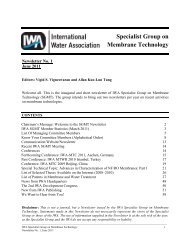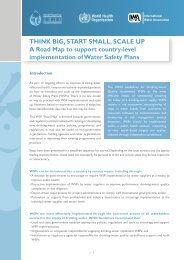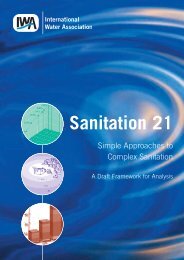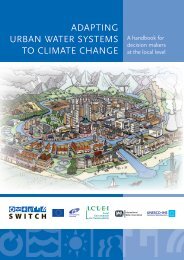Water and Energy - Draft Report of the GWRC Research ... - IWA
Water and Energy - Draft Report of the GWRC Research ... - IWA
Water and Energy - Draft Report of the GWRC Research ... - IWA
You also want an ePaper? Increase the reach of your titles
YUMPU automatically turns print PDFs into web optimized ePapers that Google loves.
The research was sponsored by AwwaRF, EPRI-CEC, <strong>and</strong> East Bay Municipal Utility District<br />
<strong>and</strong> published by AwwaRF. The project concept was partially driven by electric utility<br />
deregulation, which presents an opportunity to lower energy costs for water utilities that can<br />
optimally manage <strong>and</strong> control <strong>the</strong>ir systems. ‘Quality <strong>and</strong> supply’ are <strong>the</strong> boundaries under<br />
which <strong>the</strong> optimization problem can be initiated <strong>and</strong> solved.<br />
A Total <strong>Energy</strong> <strong>and</strong> <strong>Water</strong> Quality Management System (Ladner, Talley, <strong>and</strong> van Buskirk,<br />
1999)<br />
The research was sponsored by AwwaRF <strong>and</strong> EPRI-CEC <strong>and</strong> published by EPRI. The report<br />
develops a generic model for an energy <strong>and</strong> water quality management system (EWQMS) for <strong>the</strong><br />
water community, <strong>and</strong> defines st<strong>and</strong>ard specifications for s<strong>of</strong>tware applications required to<br />
minimize energy costs within <strong>the</strong> constraints <strong>of</strong> water quality <strong>and</strong> operation goals. Eleven<br />
drinking water utilities provided input to <strong>the</strong> requirements <strong>of</strong> <strong>the</strong> EWQMS.<br />
Implementing a Prototype <strong>Energy</strong> <strong>and</strong> <strong>Water</strong> Quality Management System (Jentgen et. al.,<br />
2003)<br />
AwwaRF <strong>and</strong> EPRI introduced <strong>the</strong> concept <strong>of</strong> an EWQMS in a February 1997 report. The report<br />
defined an EWQMS as a collection <strong>of</strong> application s<strong>of</strong>tware programs that provide information<br />
used to develop plans that solve water quality, supply, <strong>and</strong> energy management problems. Users<br />
receive information <strong>and</strong> prepare plans for daily decision-making. These plans are developed<br />
using optimization <strong>and</strong> simulation techniques embedded in <strong>the</strong> s<strong>of</strong>tware programs. The report<br />
describes <strong>the</strong> implementation effort at Colorado Spring Utilities.<br />
Optimizing Operations at JEA’s <strong>Water</strong> System (Jentgen et. al., 2005)<br />
The research was a tailored collaboration project with JEA <strong>Water</strong> <strong>and</strong> Wastewater, which<br />
extended <strong>the</strong> experience <strong>of</strong> <strong>the</strong> previous EWQMS projects to s<strong>of</strong>tware implementation,<br />
installation, testing, calibration, <strong>and</strong> daily operations <strong>of</strong> an optimization system. The project<br />
exp<strong>and</strong>ed previously developed s<strong>of</strong>tware for optimized system controls <strong>of</strong> aquifer resources<br />
(OSCAR) that was developed to minimize cost while improving water quality <strong>and</strong> better<br />
managing water resources; describes benefits <strong>of</strong> optimizing operations <strong>and</strong> includes functional<br />
s<strong>of</strong>tware specifications; <strong>and</strong> documents experience <strong>and</strong> lessons learned in <strong>the</strong> implementation,<br />
calibration, <strong>and</strong> operation <strong>of</strong> <strong>the</strong> OSCAR s<strong>of</strong>tware.<br />
Quality <strong>Energy</strong> Efficiency Retr<strong>of</strong>its for <strong>Water</strong> Systems (1997)<br />
The project was funded by <strong>the</strong> California <strong>Energy</strong> Commission, AwwaRF <strong>and</strong> EPRI-CEC <strong>and</strong><br />
published by EPRI. The manual provides information that can help operations <strong>and</strong> engineering<br />
staff in water supply facilities successfully implement common energy efficiency improvements.<br />
The manual’s scope is limited to project implementation issues.<br />
Best Practices for <strong>Energy</strong> Management (Jacobs, Kerestes, <strong>and</strong> Riddle, 2003)<br />
The research developed <strong>and</strong> documented a consortium benchmarking process for water utility<br />
application, <strong>and</strong> tested <strong>the</strong> application <strong>of</strong> <strong>the</strong> process in an energy management benchmarking<br />
study. The project resulted in documentation <strong>of</strong> more than 20 best practices in energy<br />
management <strong>and</strong> a survey tool for utilities to use in assessing <strong>and</strong> planning <strong>the</strong>ir own energy<br />
management. The best practices included a description, metrics to measure <strong>the</strong>m, obstacles in<br />
applying <strong>the</strong>m, <strong>and</strong> benefits achieved in using <strong>the</strong>m.<br />
<strong>Water</strong> <strong>and</strong> Wastewater Industry <strong>Energy</strong> Efficiency: A <strong>Research</strong> Roadmap (Means, 2004)<br />
<strong>GWRC</strong> <strong>Water</strong> & <strong>Energy</strong> - <strong>Draft</strong> report<br />
46

















